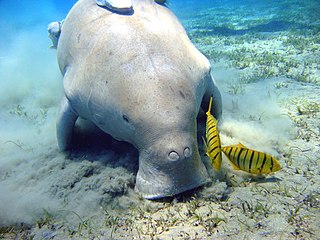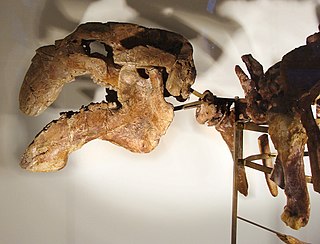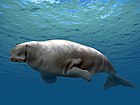
The Sirenia, commonly referred to as sea cows or sirenians, are an order of fully aquatic, herbivorous mammals that inhabit swamps, rivers, estuaries, marine wetlands, and coastal marine waters. The extant Sirenia comprise two distinct families: Dugongidae and Trichechidae with a total of four species. The Protosirenidae and Prorastomidae families are extinct. Sirenians are classified in the clade Paenungulata, alongside the elephants and the hyraxes, and evolved in the Eocene 50 million years ago (mya). The Dugongidae diverged from the Trichechidae in the late Eocene or early Oligocene.

Dugongidae is a family in the order of Sirenia. The family has one surviving species, the dugong, one recently extinct species, Steller's sea cow, and a number of extinct genera known from fossil records.

The Desmostylia are an extinct order of aquatic mammals native to the North Pacific from the early Oligocene (Rupelian) to the late Miocene (Tortonian). Desmostylians are the only known extinct order of marine mammals.

Halitherium is an extinct dugongid sea cow that arose in the late Eocene, then became extinct during the early Oligocene. Its fossils are common in European shales. Inside its flippers were finger bones that did not stick out. Halitherium also had the remnants of back legs, which did not show externally. However, it did have a basic femur, joined to a reduced pelvis. Halitherium also had elongated ribs, presumably to increase lung capacity to provide fine control of buoyancy. A 2014 review presented the opinion that the genus is dubious.

Desmostylus is an extinct genus of herbivorous mammal of the family Desmostylidae living from the Chattian stage of the Late Oligocene subepoch through the Late Miocene subepoch and in existence for approximately 21.2 million years.

Pezosiren portelli, also known as the "walking manatee", is a basal sirenian from the early Eocene of Jamaica, 50 million years ago. The type specimen is represented by a Jamaican fossil skeleton, described in 2001 by Daryl Domning, a marine mammal paleontologist at Howard University in Washington, DC. It is believed to have had a hippopotamus-like amphibious lifestyle, and is considered a transitional form between land and sea mammals.

Eotheroides is an extinct genus of Eocene sirenian. It is an early member of the family Dugongidae, which includes the extant dugong. Fossils have been found from Egypt, India, and Madagascar. Eotheroides was first described by Richard Owen in 1875 under the name Eotherium, which was replaced by the current name in 1899.

Metaxytherium is an extinct genus of dugong that lived from the Oligocene until the end of the Pliocene. Fossil remains have been found in Africa, Europe, North America and South America. Generally marine seagrass specialists, they inhabited the warm and shallow waters of the Paratethys, Mediterranean, Caribbean Sea and Pacific coastline. American species of Metaxytherium are considered to be ancestral to the North Pacific family Hydrodamalinae, which includes the giant Steller's sea cow.

Protosiren is an extinct early genus of the order Sirenia. Protosiren existed throughout the Lutetian to Priabonian stages of the Middle Eocene. Fossils have been found in the far-flung locations like the United States, Africa (Egypt), Europe and Asia.

Kutchisiren is an extinct genus of mammal which existed in what is now India in Khari Nadi Formation during the Miocene period. It was named by S. Bajpai, D. P. Domning, D. P. Das, J. Velez-Juarbe, and V. P. Mishra in 2010, and the type species is Kutchisiren cylindrica. It was originally named Kotadasiren gracilis in 1994, by Das and Basu.
The Parachucla Formation is a geologic formation in the southeastern United States. It preserves fossils from the Aquitanian stage of the early Miocene period. The formation is included in the Hawthorn Group. An exposure at the northern end of the formation has produced fossils estimated to be 19.4 to 20.5 Million years ago (Ma). Another exposure at the southern end of the formation has produced fossils estimated to be 23.9 to 24.7 Ma.
The Tauchen Formation is a geologic formation in Austria. It preserves fossils of Metaxytherium, dating back to the Langhian stage of the Miocene period.

Dusisiren is an extinct genus of dugong related to the Steller's sea cow that lived in the North Pacific during the Neogene.

Lentiarenium was an early sea cow from the Late Oligocene (Chattian) Linz-Melk Formation of Austria. Known since the mid 19th century, Lentiarenium was long considered to be a species of Halitherium until a 2016 analysis showed it to be distinct.
Italosiren is an extinct genus of early dugong from the Early Miocene (Aquitanian) Libano Formation in Northern Italy.

Crenatosiren is an extinct genus of dugongid sirenian known from the late Oligocene (Chattian) of Florida, North Carolina, and South Carolina. The type and only known species is Crenatosiren olseni.

Domningia is an extinct genus of mammal which existed in what is now India during the Miocene period. It is named in honor of Daryl Domning, a sirenian specialist.
Pachyacanthus is an extinct genus of toothed whale that lived about 15.97 to 2.589 million years ago. It contains the single species Pachyacanthus suessi. The genus is known from European deposits in Hungary, Kazakhstan, Austria and Italy. The type specimen consisted of a few fragments of a rostrum and two fragmentary tympanic bullae. Skeletons from the Sarmatian of Austria did not include skulls.

Stegosiren was an early sea cow from the Middle Oligocene of South Carolina, US. It shows a stage of halitheriine evolution more derived than that of the Old World early Oligocene Eosiren imenti and Halitherium schinzii.

Sunil Bajpai is the Chair Professor of Vertebrate Paleontology in the Department of Earth Sciences, Indian Institute of Technology Roorkee. He is in service as a professor at IIT Roorkee since 1st January 1996 till 30 September 2026. He also served as the director of the Birbal Sahni Institute of Palaeosciences from January 2013 to July 2018.
















